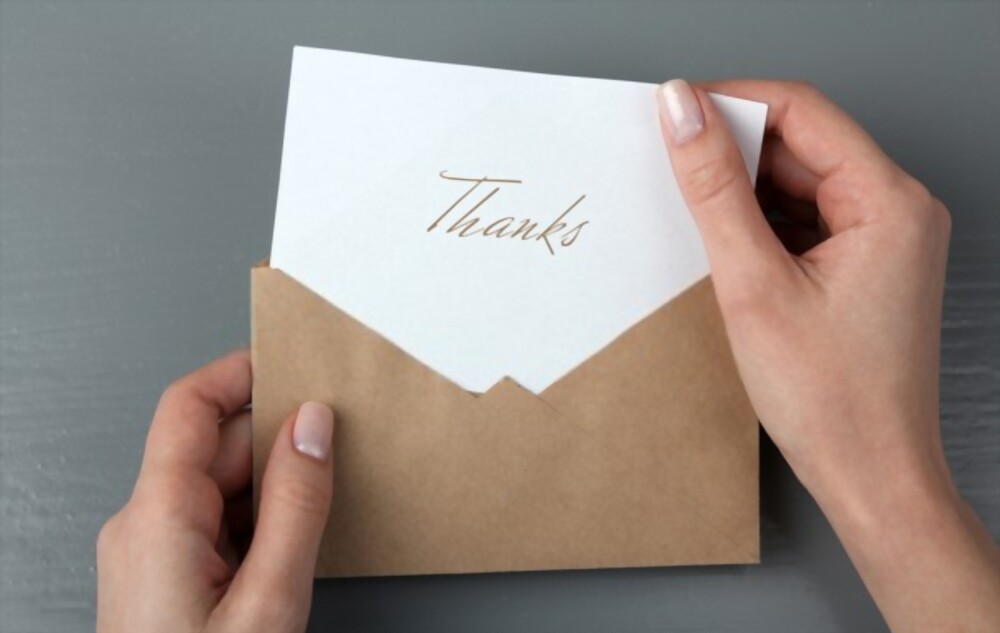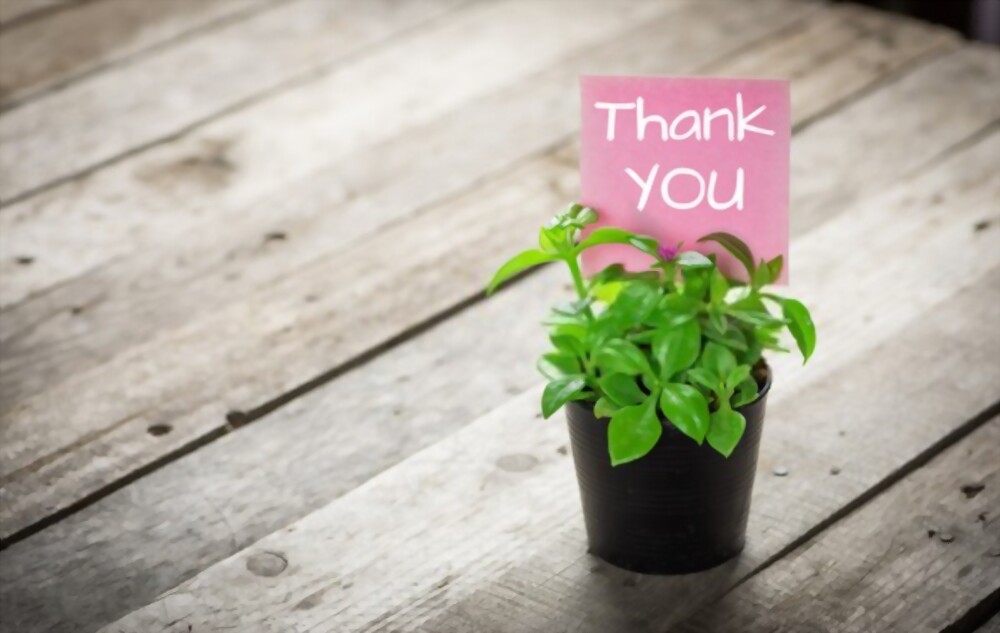The perfect thank you card is the one that expresses your gratitude for a special occasion. But finding a thank you card with the right size can be tricky. That’s why it’s important to know the standard sizes available so that you can pick the one which suits your needs best.
The standard Thank You card sizes are two: 3 x 5 inches (7.6 x 12.7 cm) and 5 x 7 inches (12.7 x 17.8 cm).
If you’re looking for advice about sending Thank You cards, this article has you covered. Here, we’ll provide information on card sizes and etiquette, as well as answer questions like: when should I send a card, and what are the alternatives? Read on to get all the info you need!
Standard thank you card sizes:
Most thank you cards are folded cards. These cards have a short message, which could be as simple as the words “Thank you,” or an image on the front.
The two standard sizes of thank you cards are 3 inches in height by 5 inches in width or 5 inches in height by 7 inches in width. In metric measurements, these sizes translate to approximately 7.6 centimeters by 12.7 centimeters for the smaller size and 12.7 centimeters by 17.8 centimeters for the larger size.
Types of standard thank you card sizes:

Thank You cards come in a variety of sizes, but the two most popular card sizes for expressing your gratitude are:
- 3-inch by 5-inch (7.6 × 12.7-centimeters)
- 5-inch by 7-inch (12.7 × 17.8-centimeter) cards
- The size of Thank You cards can vary depending on the card manufacturer. For example, if you search online, you may find Thank You cards with dimensions:
- 5.875-inch by 8.25-inch (14.9 × 21 centimeters)
- 4.5-inch by 5.5-inch (11.4 × 14 centimeters)
- 4.25-inch by 5.6-inch (10.8 × 14.2 centimeters)
- 4.125-inch by 5.875-inch (10.5 × 14.9 centimeters)
- 3.5-inch by 2-inch (8.9 × 5.1 centimeters)
When it comes to Thank You cards, there is no one-size-fits-all approach. The size of the card is completely up to you when it comes to printing your Thank You card.
Related: What Are the Baseball Card Dimensions? How Big They Are?
Choosing the right size for your thank you card:
Thank you cards come in many different sizes, but the size of the card does not necessarily matter. What is most important is the sentiment expressed in the card and the thoughtfulness of the gesture. The recipient of the thank you card will likely appreciate the effort and consideration regardless of the size of the card.
When choosing a thank you card, there are several things to keep in mind, such as the occasion for which the card is being given, the recipient of the card, and the message you want to convey. Other factors to consider when choosing the size of a thank you card include the amount of space you have to write your message, the style and design of the card, and your personal preference. Ultimately, the size of the thank you card should be chosen based on what will best convey your gratitude and appreciation to the recipient.
Including an image on a thank you card can affect the size of the card. A card with an image may be slightly larger than a card without an image in order to accommodate the additional design element.
The cost per card may be a consideration when sending thank you cards to a large number of people, such as 200 people. In this case, it may be more cost-effective to choose a less expensive card that still conveys your gratitude and appreciation to the recipient. However, it is important to keep in mind that the cost per card should not be the only factor in deciding on a thank you card.
Tips for creating and sending thank you cards:
Here are some general guidelines for thank you card etiquette:
- Make sure to send your thank you card as soon as possible after the event or receipt of the gift. A good rule of thumb is to send the card within a week.
- Handwrite your thank you card. This adds a personal touch and shows that you took the time to write the card specifically for the recipient.
- If you are sending the thank you card to multiple people (e.g. a group of friends who threw you a surprise party), write a separate card for each person.
- Use proper mailing etiquette. This means using a mailing envelope, addressing the envelope to the recipient, and affixing enough postage.
- In the card, mention the specific gift or act of kindness that you are thanking the person for. This shows that you were paying attention and that the gesture meant something to you.
- Keep your thank you message brief and to the point. There’s no need to write a lengthy letter. A few sentences expressing your gratitude and mentioning the specific gift or act of kindness is sufficient.
- If you are sending the card by email, make sure to use a subject line that clearly indicates that it is a thank you (e.g. “Thank you for the thoughtful gift”).
- If you received a gift but were unable to attend the event (e.g. a wedding or baby shower), make sure to mention that in your thank you card. This lets the person know that you were thinking of them even though you couldn’t be there in person.
The most important thing is to show your gratitude and appreciation for the gift or act of kindness that you received. A well-written card is a simple but effective way to do this.
Events that warrant a thank you card:
There are many events that warrant a thank you card. Some examples include:
- Receiving a gift, such as for a birthday, holiday, or special occasion
- Attending a dinner party or other social event
- Being a guest in someone’s home
- Receiving help or support from someone
- Being offered a job or a promotion
- Being given a referral or recommendation
- Participating in a charitable event or fundraiser
In general, any time someone does something kind or thoughtful for you, it’s a good idea to send a thank you card to show your appreciation. Even small gestures, such as a coworker lending you a pencil or a neighbor offering you a cup of sugar, can warrant a card. The key is to let the person know that you noticed their kindness and that it means something to you.
How to show gratitude and appreciation without using a thank you card?

There are many ways to show your gratitude and appreciation besides sending a thank you card. Some alternatives include:
- Saying thank you in person: This is a simple but effective way to show your gratitude. Take the time to thank the person face-to-face, and make sure to make eye contact and smile.
- Writing a thank you note: If you can’t say thank you in person, consider writing a thank you note. This can be a handwritten note on a card or stationery, or an email or letter.
- Giving a small gift: In some cases, a small gift can be a meaningful way to show your appreciation. For example, if someone baked you a batch of cookies, you could return the favor by baking them a batch of your own.
- Doing a favor in return: Another way to show your gratitude is by doing something for the person who helped you. This could be as simple as offering to help them with a task or project, or taking them out for a cup of coffee.
- Giving a public shout-out: If you have a social media presence, consider giving a shout-out to the person who helped you. This could be a post on your Facebook page, a tweet on Twitter, or a photo on Instagram. This is a simple way to show your appreciation and also let others know about the person’s kindness.
The key is to find a way to show your gratitude that is meaningful and personal. Whether you choose to send a card, say thank you in person, or use one of the other alternatives mentioned above, the important thing is to let the person know that you appreciate what they did for you.
Conclusion:
So, In this post, I have discussed, Thank you cards are a simple but effective way to show gratitude and appreciation for gifts and acts of kindness. These cards typically come in two sizes: 3 x 5 inches (7.6 x 12.7 cm) and 5 x 7 inches (12.7 x 17.8 cm).
When choosing the size of your thank you card, consider the type of event and the number of people you are thanking. Tips for creating and sending cards include hand-writing the card, using proper mailing etiquette, and mentioning the specific gift or act of kindness.